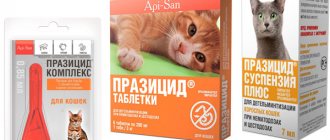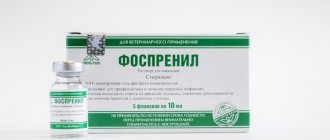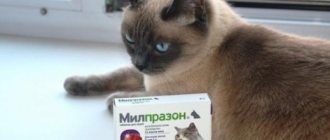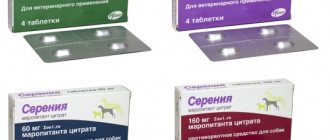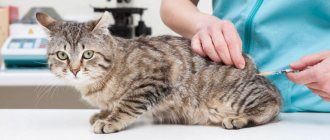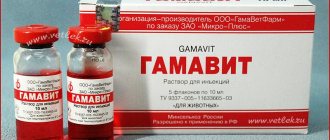- VetConsultPlus
- Informational portal
- Veterinary drug
- Drug name: Fosprenil
- Latin name: Phosprenyl
- Pharmacological group - herbal medicine, diuretic herbal extract
- Release form: Bottles of 2, 5, 10, 50, 100 ml. Bottles of 0.45 and 2 l. Liquid dosage form.
- Type of animal: Cats and other types of animals
- Active ingredient: polyprenolic phosphates
- Pharmacodynamics: metabolic, antioxidant, immunostimulant
- Indications: Additional pathogenetic therapy for infections, infestations, internal diseases
- Dose: 1 ml per kg SC, IM, orally or 1/2 dose IV, the dose can be divided into 1-3 administrations per day for 7-14 days.
- Manufacturer. Micro-plus", Moscow (Russia)
- Therapeutic efficacy evidence index: C (D)
Pharmacology
Fosprenil stimulates the main parameters of the cat’s body that regulate body homeostasis:
- Increasing the body's natural resistance
- bactericidal activity of blood serum and phagocytosis
- Strengthening the humoral immune response in cats to vaccines, thereby increasing the body's specific resistance to infections
- Reduces the incidence of disease in kittens
- Activates metabolic processes in cells, tissues and organs
- Has minor antiviral activity against herpesviruses, orthomyxoviruses, paramyxoviruses, togaviruses, feline coronaviruses
- Minor hepatoprotective, cardioprotective, and antioxidant properties have been described
Information about contraindications and side effects
Fosprenil is contraindicated in cases of increased individual sensitivity of the animal to its components.
The appearance of side effects during treatment with this veterinary drug is possible in the form of:
- a slight increase in the animal’s body temperature;
- lethargy and fatigue;
- general malaise;
- changes in heart rhythm.
The appearance of such symptoms is rare. Side effects go away on their own in a short period of time. This can be explained by the fact that the active component of the drug is related to the substances contained in animal cells.
Procedure for use and dosage of fosprenil
Fosprenil is prescribed to cats (strictly according to the instructions) to stimulate nonspecific resistance, to prevent and treat viral infections, enhance the immune response to the vaccine, and reduce morbidity. The drug is administered intramuscularly, subcutaneously, intravenously or orally. If necessary, the product can be used to wash the mucous membrane of the eye and nasal cavity in domestic cats.
When treating viral and bacterial infections in kittens, Fosprenil is prescribed for 5-7 days in doses:
- 0.25 kg body weight - single dose 0.075 ml, daily dose - 0.25 ml
- 0.5 kg body weight - single dosage - 0.15 ml, daily dosage - 0.5 ml
- 0.75 kg body weight - single dose 0.225 ml, daily dose - 0.75 ml
- 1 kg of body weight - single dose 0.3 ml, daily dose - 1 ml
- 1.5 kg body weight - single dose 0.45 ml, daily dose - 1.5 ml
- 2 kg body weight - single dose 0.6 ml, daily dose - 2 ml
When treating viral and bacterial infections in cats, Fosprenil is prescribed for 5-7 days in doses:
- 3 kg body weight - single dose 0.6 ml, daily dose - 2.1 ml
- 3.5 kg body weight - single dose 0.7 ml, daily dose - 2.45 ml
- 4 kg body weight - single dose 0.8 ml, daily dose - 2.8 ml
- 4.5 body weight - single dose 0.9 ml, daily dose - 3.15 ml
- 5 kg body weight - single dosage - 1 ml, daily dosage - 3.5 ml
- 6 kg body weight - single dose 1.2 ml, daily dose - 4.2 ml
Fosprenil, in large daily doses, should be administered to cats either at two or three points, or in three to four injections throughout the day, or half the dose intravenously.
Use of fosprenil in other animals
The medicine is used to reduce the level of morbidity and mortality in livestock from conditional infections of a pathogenic type; fosprenil increases weight gain while reducing the cost of feeding young horses, pigs, and chickens. The prophylactic drug is administered intramuscularly in an amount of 0.05 ml per kilogram of live weight or used to add to the feed.
The same norm has been established to increase the immune response to the introduction of various vaccines. If revaccination is performed, the product is not used. After prophylactic use of fosprenil, animal and poultry meat can be used for culinary purposes without restrictions.
Personal prevention measures
According to the instructions, empty drug containers must not be used for household purposes; it must be disposed of with household waste. If the drug accidentally gets on the skin or mucous membranes, it should be washed off immediately with running water and soap. When using Fosprenil, it is necessary to follow the rules of personal hygiene and safety precautions provided for when working with medicinal products for veterinary use. At the end of the work, you should thoroughly wash your face and hands with soap and rinse your mouth with water.
People with hypersensitivity to the components of the drug should avoid direct contact with Fosprenil. All work with the drug should be carried out using special clothing and personal protective equipment (rubber gloves, goggles, respirator or protective mask). While working with the drug, do not drink, smoke or eat. If allergic reactions occur and/or if the drug accidentally enters the human body, you should immediately contact a medical facility (bring with you the instructions for use of the drug or the label).
| AGREED Deputy Head of Rosselkhoznadzor ________________________ ________________________ ________________________ |
INSTRUCTIONS
on the use of Fosprenil to stimulate nonspecific resistance
and treatment of viral infections in animals and birds
(developer organization: Micro-plus CJSC, 123098 Moscow, Gamaleyi St., 18)
1. General information
1. Trade name of the drug: Phosprenyl.
International nonproprietary name: disodium salt of polyprenols phosphate.
2. Dosage form: solution for injection.
Fosprenil contains 4 mg of disodium salt of polyprenols phosphate in 1 ml as an active substance, and glycerin, ethanol, Tween-80 and water for injection as excipients.
3. In appearance, the drug is a transparent or slightly opalescent solution, colorless or with a yellowish tint.
The shelf life of the medicinal product, subject to storage conditions, is 2 years from the date of production. After opening the initial packaging, the drug cannot be stored.
Do not use Fosprenil after the expiration date.
4. Fosprenil is produced packaged in 10 ml and 50 ml glass bottles of appropriate capacity, sealed with rubber stoppers reinforced with aluminum caps.
Vials with the drug are placed in cardboard packs. Each unit of packaging is supplied with instructions for use.
5. Fosprenil should be stored in the manufacturer’s sealed packaging, separate from food and feed, in a dry place, protected from direct sunlight, at a temperature of 4°C to 25°C.
6. The drug should be stored out of the reach of children.
7. Unused medicinal product is disposed of in accordance with legal requirements.
8. Dispensing conditions: without a veterinarian's prescription.
II Pharmacological properties
9. Fosprenil is an antiviral drug with immunomodulatory properties.
10. Disodium salt of polyprenols phosphate, which is part of the drug, activates natural resistance systems (bactericidal activity of blood serum and phagocytosis), enhances the humoral immune response to vaccines, thereby increasing the body's resistance to infections and reducing morbidity. Disodium phosphate salt of polyprenols activates metabolic processes in cells and, accordingly, increases weight gain while reducing feed costs. Disodium phosphate salt of polyprenols has antiviral activity against paramyxoviruses, orthomyxoviruses, togaviruses, herpesviruses, coronaviruses and some other viruses. After parenteral administration, disodium salt of polyprenols phosphate enters the animal’s bloodstream, accumulates mainly in the tissues of the liver, spleen and reproductive organs, reaching maximum concentrations after 0.5-3 hours and remains at a therapeutic level for 10-16 hours. It is excreted from the body mainly in feces and urine.
In terms of the degree of impact on the body, Fosprenil is classified as a low-hazard substance (hazard class 4 according to GOST 12.1.007-76); in recommended doses it does not have a locally irritating, allergenic, embryotoxic, teratogenic or carcinogenic effect.
III. Application procedure
11. Fosprenil is used in agricultural animals, domestic animals, fur-bearing animals and poultry to stimulate nonspecific resistance, for the prevention and treatment of viral infections, enhancing the immune response to vaccine administration, reducing morbidity and increasing weight gain in animals and poultry.
12. A contraindication to the use of the drug is the increased individual sensitivity of animals and birds to the components of Fosprenil.
13. The drug can be used in various ways: intramuscularly, subcutaneously, intravenously (in horses and productive animals) or orally.
Treatment with Fosprenil should be started as early as possible after the onset of clinical signs of the disease. Therapy is most effective in the prodromal period. For viral infections, it is necessary to combine Fosprenil with symptomatic and pathogenetic therapy, especially in severe and complicated forms of infections. In severe cases of the disease, it is recommended to double the therapeutic dose of Fosprenil. Treatment is stopped 2-3 days after the main symptoms of the disease disappear. If necessary, repeated courses of treatment may be prescribed.
When treating viral infections of small domestic animals, Fosprenil is prescribed for 5-7 days in the doses (ml/kg) indicated in Table 1.
Table 1
| Animal species | Puppies | Dogs | Kittens | Cats |
| Single dose | 0,3 | 0,2 | 0,3 | 0,2 |
| Daily dose | 0,9-1,2 | 0,6-0,8 | 0,9-1,2 | 0,6-0,8 |
With a large daily dose, Fosprenil should be administered either at two or three points, or in three to four injections during the day.
For canine distemper in dogs, in order to avoid relapses, the drug should be administered for at least 14 days, even if the clinical signs of the disease disappear. The duration of the course, if necessary, can be increased to 1 month.
For the purpose of nonspecific prevention of diseases and reduction of mortality, Fosprenil is administered at a dose of 0.05 ml/kg body weight according to the schedule indicated in Table 2.
table 2
| Kind of animal | Infections | Method of administration | Number of injections | |||||
| Days after starting prophylaxis: | ||||||||
| 1 | 2 | 3 | 5 | 10 | 15 | |||
| Pigs | Intestinal | in/muscularly, orally | 1 | 1 | 1 | |||
| Chickens | Respiratory | aerosol* | 1 | 1 | 1 | 1 | 1 | 1 |
| Intestinal | orally | 1 | 1 | 1 | ||||
| Horses | Respiratory | IV | 1 | 1 | 1 | 1 | 1 | 1 |
| Intestinal | IV | 1 | 1 | 1 | ||||
| Minks | Secondary infections in Aleutian disease | orally | Once every 5-7 days during the entire production cycle | |||||
* - to prepare a working solution, 20 ml of Fosprenil is diluted in 1 liter of water with 10% glycerin and sprayed using aerosol generators such as SAG or APA at the rate of 0.4 ml of working solution per 1 m3 of poultry room with an exposure of 15 minutes.
To reduce morbidity, mortality, increase weight gain, reduce feed costs for young animals (pigs, horses, cattle) and poultry (chickens) in the first month of life, Fosprenil is administered in a prophylactic dose of 0.05 ml/kg intramuscularly, orally or in birds with water on the 2nd, 5th, 10th, 14th and 20th days of life. Fosprenil is given to fur-bearing animals with food once every 7 days during the 1st month after weaning, then once every 14 days before slaughter.
In order to increase the immune response to vaccines and prevent post-vaccination complications, Fosprenil at a dose of 0.05 ml/kg is administered simultaneously with the vaccine in different syringes intramuscularly, orally or in birds with water. The drug is not used for revaccination.
14. There have been no cases of overdose, side effects or complications with the use of Fosprenil.
15. No specific effects were identified during the first use of the drug and upon its discontinuation.
16. Fosprenil can be used in pregnant animals, in animals during lactation and in the offspring of animals and birds.
17. Omissions should be avoided when administering the next dose of Fosprenil, as this may lead to a decrease in the therapeutic effectiveness of the drug. If you miss one dose, give it as soon as possible. Further, the interval until the next administration of the drug does not change.
18. When using Fosprenil in accordance with these instructions, side effects and complications, as a rule, are not observed.
If allergic reactions occur, stop using the drug and prescribe antihistamines or other symptomatic treatment.
19. The drug is not recommended for use with steroid drugs due to a decrease in the therapeutic effect of Fosprenil. It is not recommended to dilute Fosprenil with saline solutions.
20. Products from animals and birds that have been treated with Fosprenil are used for food purposes without restrictions.
IV. Personal prevention measures
21. When using the drug, it is necessary to follow the rules of personal hygiene and safety precautions provided for when working with medicinal products for veterinary use.
22. All work with Fosprenil should be carried out using special clothing and personal protective equipment (rubber gloves, goggles, respirator or protective mask). While working with the drug, do not drink, smoke or eat. At the end of the work, you should thoroughly wash your face and hands with soap and rinse your mouth with water.
Empty medicinal product containers must not be used for household purposes; it must be disposed of with household waste.
23. People with hypersensitivity to the components of the drug should avoid direct contact with Fosprenil. If the drug accidentally gets on the skin or mucous membranes, it should be washed off immediately with running water and soap. If allergic reactions occur and/or if the drug accidentally enters the human body, you should immediately contact a medical facility (bring with you the instructions for use of the drug or the label).
Learn about essential antimicrobials in animals
- Trichopolum instructions for veterinary medicine
- Instructions for the use of the antibiotic Baytril in animals
- Instructions for use of metronide
- Instructions for ceftriaxone preparations for animals
- Use of Metrogyl in veterinary medicine
- Instructions for doxycycline in animals
- Metronidazole (Metronidazole) for animals (instructions for use in veterinary medicine, doses, indications and contraindications)
- Atovaquone (ATOVAQUONE)
- Azithromycin, instructions for animal therapy
^Top
List of indications for use
Veterinarians prescribe the use of Fosprenil for diseases and painful conditions diagnosed in an animal:
- panleukopenia;
- rhinotracheitis;
- alcivirosis;
- cases of cat flu;
- herpes infections;
- colitis and enteritis of an infectious nature;
- peritonitis;
- cases of food poisoning;
- ailments of unknown etiology affecting the gastrointestinal tract.
Fosprenil is prescribed to an animal by a veterinarian if he is diagnosed with certain diseases such as panleukopenia, rhinotracheitis, cat flu and others.
Interaction with other drugs
For severe and moderate forms of viral infections, it is necessary to use the drug in combination with antibiotics, antihistamines and symptomatic therapy aimed at correcting water-salt and acid-base balance, detoxifying the body, normalizing body temperature and maintaining the functions of vital organs.
Combination with interferon drugs and interferon inducers increases the effectiveness of treatment.
Fosprenil should not be used in combination with steroidal anti-inflammatory drugs (glucocorticoid hormones).
Release form. The drug is a transparent or slightly opalescent solution without mechanical impurities, colorless or with a yellowish tint.
Composition and release form
The drug is available in the form of a solution intended for injection, which is also used orally. The drug is bottled in transparent glass bottles with a volume of 10 to 100 ml. The medicine is also packaged in ampoules of 2 ml and 5 ml. The solution is colorless, sometimes with a slight yellowish tint.
The active ingredient in the composition is disodium salt of polyprenols phosphate, obtained from pine needles. Additional components of the composition: glycerin, ethyl alcohol, polysorbate 80 and water for injection.
Analogues of the drug
The list of immunomodulatory and antiviral drugs for cats with an effect identical to Fosprenil includes several drugs. Their composition and active substances differ, but the main effect is similar:
- Gamavit. It is produced on the basis of animal placenta and is a dietary supplement containing amino acids, vitamins and mineral components. Dietary supplements are available in the form of sterile injection solutions or preparations for oral administration.
- Maxidin. The formula is based on organogermanium compounds and is a powerful immunomodulator in the form of an injection solution or eye drops.
- Forvet. It is an active complex based on mono- and polysaccharides from plant materials. There are 2 forms of the medicine: injection solution and eye drops.
Fosprenil is a universal antiviral and immunomodulatory drug that is widely used by veterinarians and pet owners as a therapeutic and prophylactic agent. When treating cats, the medication does not cause adverse reactions and demonstrates high effectiveness.
Pregnant, lactating and kittens
The main contraindication to the use of Fosprenil is individual intolerance to the active substance and other components of the drug. In the absence of this factor, the drug can be used at any age for representatives of different breeds.
In addition, Fosprenil is not contraindicated in pregnant and lactating cats, as well as kittens. However, when polyprenols are administered during pregnancy, the pet must be monitored by a veterinarian. Identical control is needed when treating kittens with the drug.
Information on the cost of veterinary medicine and its analogues
Fosprenil is available in veterinary pharmacies without a prescription. On average, the cost of packaging 5 bottles of them, with a capacity of 10 milliliters each, is 850 rubles.
You can buy Fosprenil at any veterinary pharmacy without a doctor's prescription.
Among Fosprenil analogues one can see many veterinary drugs with immunomodulating properties. We are talking about Gamavit, Maksidin, Forvet and others.
The main role of the immune system is to maintain homeostasis by recognizing foreign antigens. Violations of its functions can be corrected with the help of immunotropic drugs, including immunomodulators. Immunomodulators are most widely used to treat dogs and cats. In livestock farming, immunomodulators are used for therapeutic and prophylactic purposes to increase natural resistance, stimulate the growth and development of young animals, in pathological conditions accompanied by a decrease in immunoreactivity, including viral and bacterial diseases, to normalize the blood count, prevent and correct stress and its consequences, for detoxification, etc.
Among herbal preparations, Fosprenil (sodium polyprenyl phosphate, from Siberian fir needles), which has immunomodulatory, antiviral, anti-inflammatory, adjuvant and other pharmacological activities, is widely used in animal husbandry.
V. Lavrenova, marketer at the publishing house "Agricultural Technologies"
https://www.tsenovik.ru/articles/veterinariya/immunobiologicheskie-preparaty-dlya-produktivnykh-zhivotnykh/
Table: list of drugs analogues of Fosprenil
| Veterinary medicine | Manufacturer information | Components | Who is it shown to? | List of contraindications | Information about the release form | Price |
| Gamavit | (Russia Moscow) | The active ingredients are presented in the form of denatured emulsified placenta and sodium nucleinate in saline solution, which contains amino acids and vitamins. | Prescribed to stimulate growth and development, for the preventive purpose of anemia, rickets and other ailments. Prescribed for stressful situations, exhaustion, dermatitis, hypovitaminosis, toxicosis in pregnant individuals | Hypersensitivity to the ingredients of the drug | Injection solution in a glass bottle of 6, 10 and 100 ml | From 150 rub. for 10 ml |
| Maxidin | (Russia Moscow) | The main component is germanium bis (pyridine-2,6-dicarboxylate) 1.5 mg or 4 mg. Excipients include:
| For therapy:
| Intolerance to the components of the medication | Eye and intranasal drops in 5 ml containers. Injection solution in a 5 ml bottle (5 pcs. in a pack) | From 60 rub. for a bottle of eye drops |
| Forvet | (Russia, Sergiev Posad) | The active ingredient is panavira. Auxiliary: sodium chloride and injection water | Prescribed in the complex treatment of infectious diseases of the conjunctiva and cornea | Hypersensitivity to the constituent ingredients of the veterinary drug | Injection solution in ampoules of 5 ml or bottles of 5, 10, 20, 50 and 100 ml. Eye drops 10 ml | From 370 rub. per pack (3 bottles) |
Photo gallery: Fosprenil analogues
The most popular immunostimulating veterinary drug is Gamavit
Forvet is used in the complex treatment of infectious diseases of the conjunctiva and cornea
Maxidin is used for the treatment of rhinitis, conjunctivitis in cats
Reviews about the treatment
Kirill, veterinarian: “Fosprenil is an effective and proven drug for combating viral diseases. Thanks to its safe composition, it has virtually no contraindications and is suitable for different breeds of cats. There are no significant disadvantages or side effects.”
Svetlana, Arkhangelsk: “In my city, Fosprenil is not a common drug, which is a pity. I give my cat medicine not only to fight viral diseases, but also as a preventive measure. We managed to cure 7 kittens with herpes virus.”
Properties
Fosprenil has a broad spectrum of antiviral action both in vitro and in vivo; increases the body's resistance to diseases caused by parvoviruses, caliciviruses, herpesviruses, paramyxoviruses, as well as a number of other animal viruses.
The drug modulates, within physiological limits, the functioning of the natural resistance system, has anti-inflammatory activity, enhances the immune response to vaccines, is a hepatoprotector and detoxicant, and stimulates the growth and development of animals.

